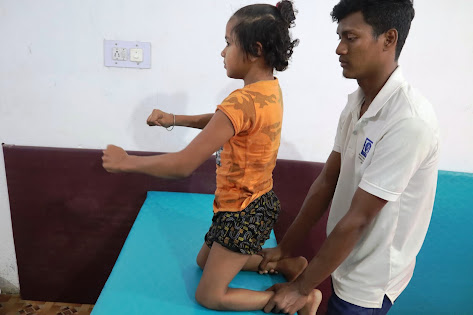ATHETOID CEREBRAL PALSY THERAPY PATTERNS
THERAPEUTIC INTERVENTION
FOR
"ATHETOID CEREBRAL PALSY"
1. Therapy Program for Athetoid Cerebral Palsy
Therapy for this type of CP is typically based on mobility development and to bring in more voluntary motor control by controlling unwanted reflexes that hinders in coordination and balancing the movements. This includes exercising and working on holding posture or keeping the body in a steady, upright position. Physiotherapist uses various exercises to increase the strength in these muscles and prevent any further complications.
Physiotherapist plays a great and vital role for children with Athetoid cerebral palsy to overcome any sensory impairment, such as touch and depth perception that make movement more difficult.
In the other way Occupational therapist works on to enhance a child's ability to independently play and learn. An occupational therapist will help to make everyday tasks, such as grasping objects, writing or using various modalities that make the child to put easier effort of bringing voluntary motor control in action through sustained effort and practice. Specific exercises used in occupational therapy for Athetoid CP include activities through passive stretching with weights and assistive equipment's by incorporating functional and playful activities to keep children focused on tasks by playful methods. Occupational therapy is way and procedure that allows children to form relationships and respond to the demands of daily life with increased mobility and confidence.
2. Therapy pattern for Athetoid cerebral palsy
a. Hip rotation exercise to reduce tightness around hip joint and to bring flexibility
b. Knelling to reduce trunk tightness and to maintain upright posture for stability
c. Bolster balance therapy to reduce involuntary muscle contraction
d. Supine to sitting to reduce back extensor reflex
e. Half kneeling for trunk balance and stability
g. Adductor tightness release through stretching
h. Bilateral knee flexion and extension therapy for strengthening and flexibility
i. Squatting to improve independent sitting balance with stability
3. Conclusion
Cerebral Palsy is a diverse group characterized by delayed body function, disorders and neurological that is non-progressive. Although the clinical picture may change as the brain matures. There is a need to know the associated signs and symptoms. Diagnosis and thorough testing is needed to know the exact problem in a child affected by cerebral palsy.
Cerebral palsy children require a complex health care team for identification, assessment, therapy intervention and follow-up with these children that gives them the best quality of life they can have.
Early physiotherapy and occupational therapy interventions provide an opportunity for the child to practice functional activities, body positions and develop proper gait pattern. By practicing meaningful and effective skills in a variety of environments, the child will have the opportunity to acquire skills that encourage them to be more independent with the activity of daily living and to increase their level of participation in society.
Therefore, effective therapy plan for children with cerebral palsy focuses on promoting functional independence and preventing further muscle weakness by applying needful exercises according the condition.








